Pronunciation [fɒːɾˈsiː] | ||
Native speakers 45 million (2007) – 60 million (2009)(110 million total speakers) Language family Indo-EuropeanIndo-IranianIranianWestern IranianSouthwestern IranianPersian Early forms Old PersianMiddle Persian Standard forms Western PersianDariTajik | ||
The persian language and what makes it fascinating
Persian (/ˈpɜːrʒən/ or /ˈpɜːrʃən/), also known by its endonym Farsi (فارسی fārsi [fɒːɾˈsiː]), is one of the Western Iranian languages within the Indo-Iranian branch of the Indo-European language family. It is primarily spoken in Iran, Afghanistan (officially known as Dari since 1958), and Tajikistan (officially known as Tajiki since the Soviet era), and some other regions which historically were Persianate societies. It is mostly written in the Persian alphabet, a modified variant of the Arabic script.
Contents
- The persian language and what makes it fascinating
- Classification
- Persian language name in Persian
- Persian language name in English
- History
- Old Persian
- Middle Persian
- New Persian
- Early New Persian
- Classical Persian
- Use in Asia Minor
- Use in South Asia
- Contemporary Persian
- Varieties
- Phonology
- Vowels
- Morphology
- Syntax
- Native word formation
- Influences
- Orthography
- Persian alphabet
- Additions
- Variations
- Latin alphabet
- Tajik alphabet
- Examples
- References
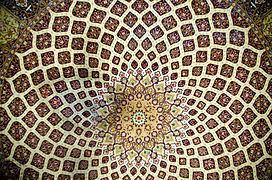
The Persian language is classified as a continuation of Middle Persian, the official religious and literary language of the Sasanian Empire, itself a continuation of Old Persian, the language of the Achaemenid Empire. Its grammar is similar to that of many contemporary European languages. Persian gets its name from its origin at the capital of the Achaemenid Empire, Persis (modern-day Fars Province), hence the name Persian (Farsi). A Persian-speaking person may be referred to as Persophone.
There are approximately 110 million Persian speakers worldwide, with the language holding official status in Iran, Afghanistan, and Tajikistan. For centuries, Persian has also been a prestigious cultural language in other regions of Western Asia, Central Asia, and South Asia by the various empires based in the regions.
Persian has had a considerable (mainly lexical) influence on neighboring languages, particularly the Turkic languages in Central Asia, Caucasus, and Anatolia, neighboring Iranian languages, as well as Armenian, Georgian, and Indo-Aryan languages, especially Urdu. It also exerted some influence on Arabic, particularly Bahrani Arabic, while borrowing much vocabulary from it after the Muslim conquest of Persia.
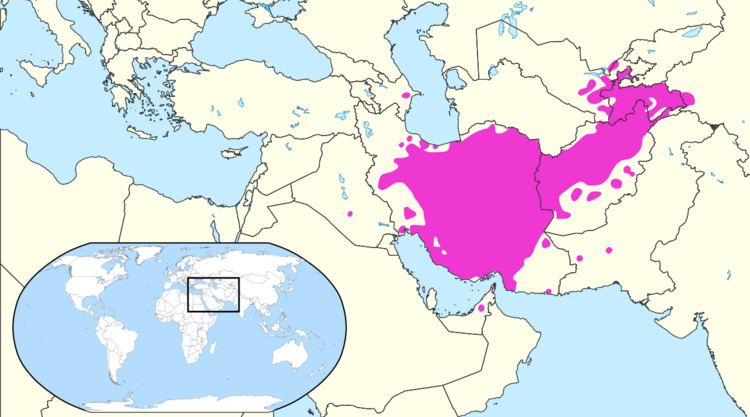
With a long history of literature in the form of Middle Persian before Islam, Persian was the first language in the Muslim world to break through Arabic's monopoly on writing, and the writing of poetry in Persian was established as a court tradition in many eastern courts. Some of the famous works of Persian literature are the Shahnameh of Ferdowsi, the works of Rumi, the Rubaiyat of Omar Khayyam, the Panj Ganj "The Five Treasures" of Nizami Ganjavi, the Divān of Hafez and the two miscellanea of prose and verse by Saadi Shirazi, the Golestān "Land of Flowers" and the Bustān "The Garden" (literally "Land of Fragrance").
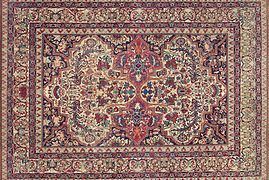
Classification
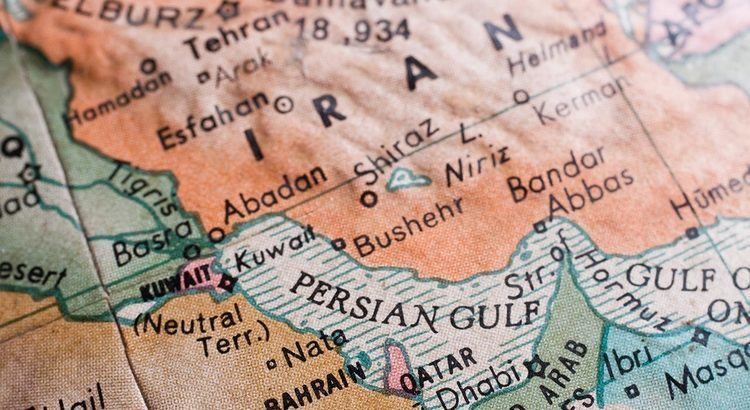
Persian is one of the Western Iranian languages within the Indo-European family. Other Western Iranian languages are the Kurdish languages, Gilaki, Mazanderani, Talysh, and Balochi. Persian is classified as a member of the Southwestern subgroup within Western Iranian along with Lari, Kumzari, and Luri.
Persian language name in Persian
In Persian, the language is known by several names:
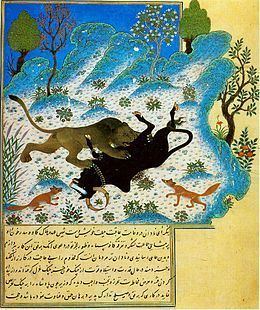
Persian language name in English
Persian, the historically more widely used name of the language in English, is an anglicized form derived from Latin *Persianus < Latin Persia < Greek Περσίς Persís "Persia", a Hellenized form of Old Persian Pārsa. According to the Oxford English Dictionary, the term Persian as a language name is first attested in English in the mid-16th century. Native Iranian Persian speakers call it Fārsi. Farsi is the Arabicized form of Pārsi, subsequent to Muslim conquest of Persia, due to a lack of the phoneme /p/ in Standard Arabic (i.e., the /p/ was replaced with an /f/). The origin of the name Farsi and the place of origin of the language which is Fars Province is the Arabicized form of Pārs. In English, this language has historically been known as Persian, though Farsi has also gained some currency. According to the Oxford English Dictionary, the term Farsi was first used in English in 1926, while Parsi dates to 1790. Farsi is encountered in some linguistic literature as a name for the language, used both by Iranian and by foreign authors.
In South Asia the word Farsi refers to the language while Parsi describes the people of Persian origin, particularly Zoroastrians.
The Academy of Persian Language and Literature has declared that the name Persian is more appropriate, as it has the longer tradition in western languages and better expresses the role of the language as a mark of cultural and national continuity. Some Persian language scholars such as Ehsan Yarshater, editor of Encyclopædia Iranica, and University of Arizona professor Kamran Talattof, have also rejected the usage of "Farsi" in their articles.
The international language-encoding standard ISO 639-1 uses the code fa, as its coding system is mostly based on the local names. The more detailed standard ISO 639-3 uses the name "Persian" (code fas) for the dialect continuum spoken across Iran and Afghanistan. This consists of the individual languages Dari (Afghan Persian) and Iranian Persian.
Currently, Voice of America, BBC World Service, Deutsche Welle, and Radio Free Europe/Radio Liberty use "Persian Service" for their broadcasts in the language. Radio Free Europe/Radio Liberty also includes a Tajik service and an Afghan (Dari) service. This is also the case for the American Association of Teachers of Persian, The Centre for Promotion of Persian Language and Literature, and many of the leading scholars of Persian language.
History
Persian is an Iranian language belonging to the Indo-Iranian branch of the Indo-European family of languages. In general, Iranian languages are known from three periods, usually referred to as Old, Middle, and New (Modern) periods. These correspond to three eras in Iranian history; Old era being the period from sometime before Achaemenids, the Achaemenid era and sometime after Achaemenids (that is to 400–300 BC), Middle era being the next period most officially Sassanid era and sometime in post-Sassanid era, and the New era being the period afterwards down to present day.
According to available documents, the Persian language is "the only Iranian language" for which close philological relationships between all of its three stages are established and so that Old, Middle, and New Persian represent one and the same language of Persian; that is, New Persian is a direct descendant of Middle and Old Persian.
The known history of the Persian language can be divided into the following three distinct periods:
Old Persian
As a written language, Old Persian is attested in royal Achaemenid inscriptions. The oldest known text written in Old Persian is from the Behistun Inscription. Examples of Old Persian have been found in what is now present-day Iran, Romania (Gherla), Armenia, Bahrain, Iraq, Turkey and Egypt. Old Persian is one of the oldest Indo-European languages which is attested in original texts.
Xenophon, a Greek general serving in some of the Persian expeditions, describes many aspects of Armenian village life and hospitality in around 401 BC, which is at a time when Old Persian was the only form of Persian used. He relates that the Armenians spoke a language that to his ear sounded like the language of the Persians.
Middle Persian
The complex grammatical conjugation and declension of Old Persian yielded to the structure of Middle Persian in which the dual number disappeared, leaving only singular and plural, as did gender. Middle Persian developed the ezāfe construction, expressed through ī (modern ye), to indicate some of the relations between words that have been lost with the simplification of the earlier grammatical system.
Although the "middle period" of the Iranian languages formally begins with the fall of the Achaemenid Empire, the transition from Old to Middle Persian had probably already begun before the 4th century. However, Middle Persian is not actually attested until 600 years later when it appears in the Sassanid era (224–651) inscriptions, so any form of the language before this date cannot be described with any degree of certainty. Moreover, as a literary language, Middle Persian is not attested until much later, to the 6th or 7th century. And from the 8th century onward, Middle Persian gradually began yielding to New Persian, with the middle-period form only continuing in the texts of Zoroastrianism.
The native name of Middle Persian was Parsig or Parsik, after the name of the ethnic group of the southwest, that is, "of Pars", Old Persian Parsa, New Persian Fars. This is the origin of the name Farsi as it is today used to signify New Persian. Following the collapse of the Sassanid state, Parsik came to be applied exclusively to (either Middle or New) Persian that was written in the Arabic script. From about the 9th century onward, as Middle Persian was on the threshold of becoming New Persian, the older form of the language came to be erroneously called Pahlavi, which was actually but one of the writing systems used to render both Middle Persian as well as various other Middle Iranian languages. That writing system had previously been adopted by the Sassanids (who were Persians, i.e. from the southwest) from the preceding Arsacids (who were Parthians, i.e. from the northeast). While Ibn al-Muqaffa' (eighth century) still distinguished between Pahlavi (i.e. Parthian) and Persian (in Arabic text: al-Farisiyah) (i.e. Middle Persian), this distinction is not evident in Arab commentaries written after that date.
Gernot Windfuhr considers new Persian as an evolution of the Old Persian language and the Middle Persian language but also states that none of the known Middle Persian dialects is the direct predecessor of Modern Persian. Ludwig Paul states: "The language of the Shahnameh should be seen as one instance of continuous historical development from Middle to New Persian."
New Persian
The history of New Persian itself spans more than 1000 years. The development of the language in its last period is often divided into three stages dubbed early, classical, and contemporary. Native speakers of the language can in fact understand early texts in Persian with minimal adjustment, because the morphology and, to a lesser extent, the lexicon of the language have remained relatively stable for the greater part of a millennium.
Early New Persian
New Persian developed from the eighth century on as an independent literary language. Upon the decline of the Abbasid Caliphate at Baghdad in the ninth century began the reestablishment of Persian national life and Persians laid the foundations for a renaissance in the realm of letters. New Persian was born in Bactria through the adaptation of the spoken form of Sassanian Middle Persian court language called Dari. The cradle of the Persian literary renaissance lay in the east of Greater Iran in Greater Khorasan and Transoxiana close to the Amu Darya.
The mastery of the newer speech having now been transformed from Middle into New Persian was already complete by the era of the three princely dynasties of Iranian origin, the Tahirid dynasty (820–872), Saffarid dynasty (860–903) and Samanid Empire (874–999), and could develop only in range and power of expression.
Abbas of Merv is mentioned as being the earliest minstrel to chant verse in the newer Persian tongue and after him the poems of Hanzala Badghisi were among the most famous between the Persian-speakers of the time.
The first poems of the Persian language, a language historically called Dari, emerged in Afghanistan. The first significant Persian poet was Rudaki. He flourished in the 10th century, when the Samanids were at the height of their power. His reputation as a court poet and as an accomplished musician and singer has survived, although little of his poetry has been preserved. Among his lost works is versified fables collected in the Kalila wa Dimna.
The language spread geographically from the 11th century on and was the medium through which among others, Central Asian Turks became familiar with Islam and urban culture. New Persian was widely used as a trans-regional lingua franca, a task for which it was particularly suitable due to its relatively simple morphological structure and this situation persisted until at least 19th century. In the late Middle Ages, new Islamic literary languages were created on the Persian model: Ottoman Turkish, Chagatai and Urdu, which are regarded as "structural daughter languages" of Persian.
Classical Persian
The Muslim conquest of Persia marks the beginning of the new history of Persian language and literature. This period produced world class Persian language poets and the language served, for a long span of time, as the lingua franca of major parts of the Muslim world and South Asia. It was also the official and cultural language of many Islamic dynasties, including the Samanids, Buyids, Tahirids, Ziyarids, the Mughal Empire, Timurids, Ghaznavids, Seljuqs, Khwarazmians, the Sultanate of Rum, the Shirvanshahs, Safavids, Afsharids, Zands, Qajars, Ottomans and also many Mughal successors such as the Nizam of Hyderabad. For example, Persian was the only non-European language known and used by Marco Polo at the Court of Kublai Khan and in his journeys through China. The heavy influence of Persian on other languages can still be witnessed across the Islamic world, especially, and it is still appreciated as a literary and prestigious language among the educated elite, especially in fields of music (for example, qawwalis) and art (Persian literature). After the Arab invasion of Persia, Persian began to adopt many words from Arabic and as time went by, a few words were even taken from Turco-Mongol languages under the Mongol Empire and Turko-Persian tradition.
Use in Asia Minor
Despite Anatolia having been ruled at various times prior to the Middle Ages by various Persian-speaking dynasties originating in Iran, the language lost its traditional foothold there with the demise of the Sasanian Empire. Centuries later however, the practise and usage of Persian in the region would be strongly revived. A branch of the Seljuks, the Sultanate of Rum, took Persian language, art and letters to Anatolia. They adopted Persian language as the official language of the empire. The Ottomans, which can roughly be seen as their eventual successors, took this tradition over. Persian was the official court language of the empire, and for some time, the official language of the empire. The educated and noble class of the Ottoman Empire all spoke Persian, such as sultan Selim I, despite being Safavid Iran's archrival and a staunch opposer of Shia Islam. It was a major literary language in the empire. Some of the noted earlier Persian works during the Ottoman rule are Idris Bidlisi's Hasht Bihisht, which begun in 1502 and covered the reign of the first eight Ottoman rulers, and the Salim-Namah, a glorification of Selim I. After a period of several centuries, Ottoman Turkish (which was highly Persianised itself) had developed towards a fully accepted language of literature, which was even able to satisfy the demands of a scientific presentation. However, the number of Persian and Arabic loanwords contained in those works increased at times up to 88%.
Use in South Asia
The Persian language influenced the formation of many modern languages in West Asia, Europe, Central Asia, and South Asia. Following the Turko-Persian Ghaznavid conquest of South Asia, Persian was firstly introduced in the region by Turkic Central Asians. The basis in general for the introduction of Persian language into the subcontinent was set, from its earliest days, by various Persianized Central Asian Turkic and Afghan dynasties. For five centuries prior to the British colonization, Persian was widely used as a second language in the Indian subcontinent, due to the admiration the Mughals (who were of Turco-Mongol origin) had for the foreign language. It took prominence as the language of culture and education in several Muslim courts on the subcontinent and became the sole "official language" under the Mughal emperors. Beginning in 1843, though, English and Hindustani gradually replaced Persian in importance on the subcontinent. Evidence of Persian's historical influence there can be seen in the extent of its influence on certain languages of the Indian subcontinent. Words borrowed from Persian are still quite commonly used in certain Indo-Aryan languages, especially Urdu, also historically known as Hindustani. There is also a small population of Zoroastrian Iranis in India, who migrated around 16th-18th century to escape religious execution in Qajar Iran and speak a Dari dialect.
Contemporary Persian
Since the nineteenth century, Russian, French and English and many other languages have contributed to the technical vocabulary of Persian. The Iranian National Academy of Persian Language and Literature is responsible for evaluating these new words in order to initiate and advise their Persian equivalents. The language itself has greatly developed during the centuries.
Varieties
There are three modern varieties of standard Persian:
All these three varieties are based on the classic Persian literature and its literary tradition. There are also several local dialects from Iran, Afghanistan and Tajikistan which slightly differ from the standard Persian. The Hazaragi dialect (in Central Afghanistan and Pakistan), Herati (in Western Afghanistan), Darwazi (in Afghanistan and Tajikistan), and the Tehrani accent (in Iran, the basis of standard Iranian Persian) are examples of these dialects. Persian-speaking peoples of Iran, Afghanistan, and Tajikistan can understand one another with a relatively high degree of mutual intelligibility.
The following are some languages closely related to Persian, or in some cases are considered dialects:
Phonology
Iranian Persian has six vowels and twenty-three consonants.
Vowels
Historically, Persian has distinguished length. Early New Persian had a series of five long vowels (/iː/, /uː/, /ɒː/, /oː/ and /eː/) along with three short vowels /æ/, /i/ and /u/. At some point prior to the 16th century in the general area now modern Iran, /eː/ and /iː/ merged into /iː/, and /oː/ and /uː/ merged into /uː/. Thus, older contrasts such as شیر shēr "lion" vs. شیر shīr "milk", and زود zūd "quick" vs زور zōr "strong" were lost. However, there are exceptions to this rule, and in some words, ē and ō are preserved or merged into the diphthongs [eɪ] and [oʊ] (which are descendants of the diphthongs [æɪ] and [æʊ] in Early New Persian), instead of merging into /iː/ and /uː/. Examples of this exception can be found in words such as روشن [roʊʃæn] (bright).
However, in the eastern varieties, the archaic distinction of /eː/ and /iː/ (respectively known as یای مجهول Yā-ye majhūl and یای معروف Yā-ye ma'rūf) is still preserved as well as the distinction of /oː/ and /uː/ (known as واو مجهول Wāw-e majhūl and واو معروف Wāw-e ma'rūf). On the other hand, in standard Tajik, the length distinction has disappeared, and /iː/ merged with /i/ and /uː/ with /u/. Therefore, contemporary Afghan Dari dialects are the closest to the vowel inventory of Early New Persian.
According to most studies on the subject (e.g. Samareh 1977, Pisowicz 1985, Najafi 2001), the three vowels traditionally considered long (/i/, /u/, /ɒ/) are currently distinguished from their short counterparts (/e/, /o/, /æ/) by position of articulation rather than by length. However, there are studies (e.g. Hayes 1979, Windfuhr 1979) that consider vowel length to be the active feature of the system, and /ɒ/, /i/, and /u/ are phonologically long or bimoraic, and /æ/, /e/, and /o/ are phonologically short or monomoraic.
There are also some studies which consider quality and quantity to be both active in the Iranian system (e.g. Toosarvandani 2004). That offers a synthetic analysis including both quality and quantity, often suggesting that modern Persian vowels are in a transition state between the quantitative system of classical Persian and a hypothetical future Persian that will eliminate all traces of quantity and retain quality as the only active feature.
The length distinction is nevertheless strictly observed by careful reciters of classic-style poetry for all varieties (including the Tajik).
Morphology
Suffixes predominate Persian morphology, though there are a small number of prefixes. Verbs can express tense and aspect, and they agree with the subject in person and number. There is no grammatical gender in Persian, and pronouns are not marked for natural gender.
Syntax
Normal declarative sentences are structured as (S) (PP) (O) V: sentences have optional subjects, prepositional phrases, and objects followed by a compulsory verb. If the object is specific, the object is followed by the word rā and precedes prepositional phrases: (S) (O + rā) (PP) V.
Native word formation
Persian makes extensive use of word building and combining affixes, stems, nouns and adjectives. Persian frequently uses derivational agglutination to form new words from nouns, adjectives, and verbal stems. New words are extensively formed by compounding – two existing words combining into a new one, as is common in German.
Influences
While having a lesser influence on Arabic and other languages of Mesopotamia and its core vocabulary being of Middle Persian origin, New Persian contains a considerable amount of Arabic lexical items, which were Persianized and often took a different meaning and usage than the Arabic original. Persian loanwords of Arabic origin especially include Islamic terms. The Arabic vocabulary in other Iranian, Turkic and Indic languages is generally understood to have been copied from New Persian, not from Arabic itself.
John R. Perry, in his article Lexical Areas and Semantic Fields of Arabic, estimates that about 24 percent of an everyday vocabulary of 20,000 words in current Persian, and more than 25 percent of the vocabulary of classical and modern Persian literature, are of Arabic origin. The text frequency of these loan words is generally lower and varies by style and topic area. It may approach 25 percent of a text in literature. Among the Arabic loan words, relatively few (14 percent) are from the semantic domain of material culture, while a larger number are from domains of intellectual and spiritual life. Most of the Arabic words used in Persian are either synonyms of native terms or could be glossed in Persian.
The inclusion of Mongolian and Turkic elements in the Persian language should also be mentioned, not only because of the political role a succession of Turkic dynasties played in Iranian history, but also because of the immense prestige Persian language and literature enjoyed in the wider (non-Arab) Islamic world, which was often ruled by sultans and emirs with a Turkic background. The Turkish and Mongolian vocabulary in Persian is minor in comparison to that of Arabic and these words were mainly confined to military, pastoral terms and political sector (titles, administration, etc.). New military and political titles were coined based partially on Middle Persian (e.g. ارتش arteš for "army", instead of the Uzbek قؤشین qoʻshin; سرلشکر sarlaškar; دریابان daryābān; etc.) in the 20th century. Persian has likewise influenced the vocabularies of other languages, especially other Indo-European languages such as Armenian, Urdu, and (to a lesser extent) Hindi; the latter two through conquests of Persianized Central Asian Turkic and Afghan invaders; Turkic languages such as Ottoman Turkish, Chagatai, Tatar, Turkish, Turkmen, Azeri, Uzbek, and Karachay-Balkar; Caucasian languages such as Georgian, and to a lesser extent, Avar and Lezgin; Afro-Asiatic languages like Assyrian (List of loanwords in Assyrian Neo-Aramaic) and Arabic; and even Dravidian languages indirectly especially Telugu and Brahui; as well as Austronesian languages such as Indonesian and Malay. Persian has also had a significant lexical influence, via Turkish, on Serbian, Croatian, Bosnian, and Serbo-Croatian, particularly as spoken in Bosnia and Herzegovina.
Use of occasional foreign synonyms instead of Persian words can be a common practice in everyday communications as an alternative expression. In some instances in addition to the Persian vocabulary, the equivalent synonyms from multiple foreign languages can be used. For example, in Iranian colloquial Persian (not in Afghanistan or Tajikistan), the phrase "thank you" may be expressed using the French word مرسی merci (stressed however on the first syllable), the hybrid Persian-Arabic phrase متشکّر ام motešakker am (متشکّر motešakker being "merciful" in Arabic, commonly pronounced motčakker in Persian, and the verb ام am meaning "I am" in Persian), or by the pure Persian phrase سپاسگزار ام sepās-gozār am.
Orthography
The vast majority of modern Iranian Persian and Dari text is written with the Arabic script. Tajiki, which is considered by some linguists to be a Persian dialect influenced by Russian and the Turkic languages of Central Asia, is written with the Cyrillic script in Tajikistan (see Tajik alphabet).
Persian alphabet
Modern Iranian Persian and Afghan Persian are written using a modified variant of the Arabic alphabet, which uses different pronunciation and additional letters not found in Arabic. Tajik Persian, as used in Tajikistan, is typically written in a modified version of the Cyrillic script. There also exist several romanization systems for Persian. After the Muslim conquest of Persia, it took approximately 150 years before Persians adopted the Arabic script in place of the older alphabet. Previously, two different scripts were used, Pahlavi, used for Middle Persian, and the Avestan alphabet (in Persian, Dīndapirak or Din Dabire—literally: religion script), used for religious purposes, primarily for the Avestan but sometimes for Middle Persian.
In the modern Persian script, historically short vowels are usually not written, only the historically long ones are represented in the text, so words distinguished from each other only by short vowels are ambiguous in writing: Western Persian kerm "worm", karam "generosity", kerem "cream", and krom "chrome" are all spelled krm (کرم) in Persian. The reader must determine the word from context. The Arabic system of vocalization marks known as harakat is also used in Persian, although some of the symbols have different pronunciations. For example, a ḍammah is pronounced [ʊ~u], while in Iranian Persian it is pronounced [o]. This system is not used in mainstream Persian literature; it is primarily used for teaching and in some (but not all) dictionaries.
There are several letters generally only used in Arabic loanwords. These letters are pronounced the same as similar Persian letters. For example, there are four functionally identical letters for /z/ (ز ذ ض ظ), three letters for /s/ (س ص ث), two letters for /t/ (ط ت), two letters for /h/ (ح ه). On the other hand, there are four letters that don't exist in Arabic پ چ ژ گ.
Additions
The Persian alphabet adds four letters to the Arabic alphabet:
Historically, there was used also a special letter for the sound /β/. This letter is used no more as the /β/-sound changed to /b/, i.e. archaic زڤان /zaβān/ > زبان /zæbɒn/ 'language'
Variations
The Persian alphabet also modifies some letters of the Arabic alphabet. For example, alef with hamza below ( إ ) changes to alef ( ا ); words using various hamzas get spelled with yet another kind of hamza (so that مسؤول becomes مسئول) even though the latter is also correct in Arabic; and teh marbuta ( ة ) changes to heh ( ه ) or teh ( ت ).
The letters different in shape are:
Latin alphabet
The International Organization for Standardization has published a standard for simplified transliteration of Persian into Latin, ISO 233-3, titled "Information and documentation – Transliteration of Arabic characters into Latin characters – Part 3: Persian language – Simplified transliteration" but the transliteration scheme is not in widespread use.
Another Latin alphabet, based on the Common Turkic Alphabet, was used in Tajikistan in the 1920s and 1930s. The alphabet was phased out in favor of Cyrillic in the late 1930s.
Fingilish is Persian using ISO basic Latin alphabet. It is most commonly used in chat, emails and SMS applications. The orthography is not standardized, and varies among writers and even media (for example, typing 'aa' for the [ɒ] phoneme is easier on computer keyboards than on cellphone keyboards, resulting in smaller usage of the combination on cellphones).
Tajik alphabet
The Cyrillic script was introduced for writing the Tajik language under the Tajik Soviet Socialist Republic in the late 1930s, replacing the Latin alphabet that had been used since the October Revolution and the Persian script that had been used earlier. After 1939, materials published in Persian in the Persian script were banned from the country.
Examples
The following text is from Article 1 of the Universal Declaration of Human Rights.
